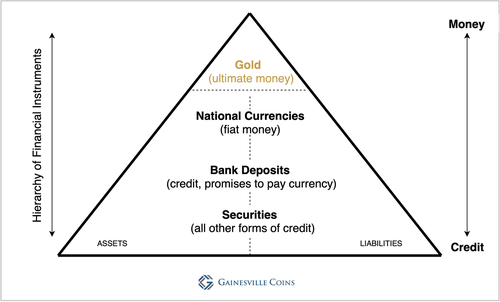2023 Banking Crisis: A bull run for gold?
According to Professor of International Political Economy Perry Mehrling, there is a natural hierarchy of money that can be visualised as a pyramid. At the very top of this pyramid is gold, a rare and universally accepted form of currency that is not dependent on the obligations of others. Following that are national currencies issued by central banks, followed by deposits created by commercial banks. Securities like bonds and stock are at the bottom of the pyramid.
Because everything except gold can be created out of thin air, the pyramid's base can be rapidly expanded. Balance sheets (assets and liabilities) expand during the business cycle, resulting in credit creation and economic growth. Balance sheets contract during a recession, and the pyramid's shape changes.
The pyramid's horizontal focus is on quantity and leverage. Vertically, the pyramid is about money quality: the higher you go up the pyramid, the better the money quality. According to Mehrling, credit becomes more like money during a boom because different types of credit become more liquid and easier to use for payments. You discover during a contraction that what you thought was money was actually credit. During a recession, you also learn that gold is superior to currency and currency is superior to deposits.
Taking into account the massive increase in the supply of fiat money, credit, and securities since the abandonment of the gold standard in 1971, the global financial system has become too big and intertwined to allow for credit contraction or debt default, so the only way to restore the pyramid-shaped financial system is through an increase in the price of gold.
An examination of the relationship between national currencies and gold using Mehrling's hierarchy of money framework, as well as an assessment of how much gold central banks are willing to hold in relation to foreign national currencies. Central banks have unusual faith in foreign exchange, and gold's percentage of total reserves has historically been around 59%, but is expected to fall to 16% by 2022. However, as evidenced by recent large purchases of gold by central banks around the world, central banks are beginning to lose confidence in currencies issued by their peers.
Gold will continue to rise in price as national currencies devalue against it in order to increase liquidity, which is a fact of life. To reset the shape of the financial pyramid, the price of gold must rise, and the article suggests that a conservative estimate of gold accounting for 51% of global international reserves would necessitate a gold price of $10,000 per troy ounce. The private sector, like central banks, has little exposure to gold versus credit assets. As a result, the gold price is expected to rise during the banking crisis as governments and institutions shift their assets to safe havens.
Source:
Jan Nieuwenhuijs, 25 March 2023, "The Hierarchy Of Money And The Case For $8,000 Gold", https://www.zerohedge.com/commodities/hierarchy-money-and-case-8000-gold?utm_source=
